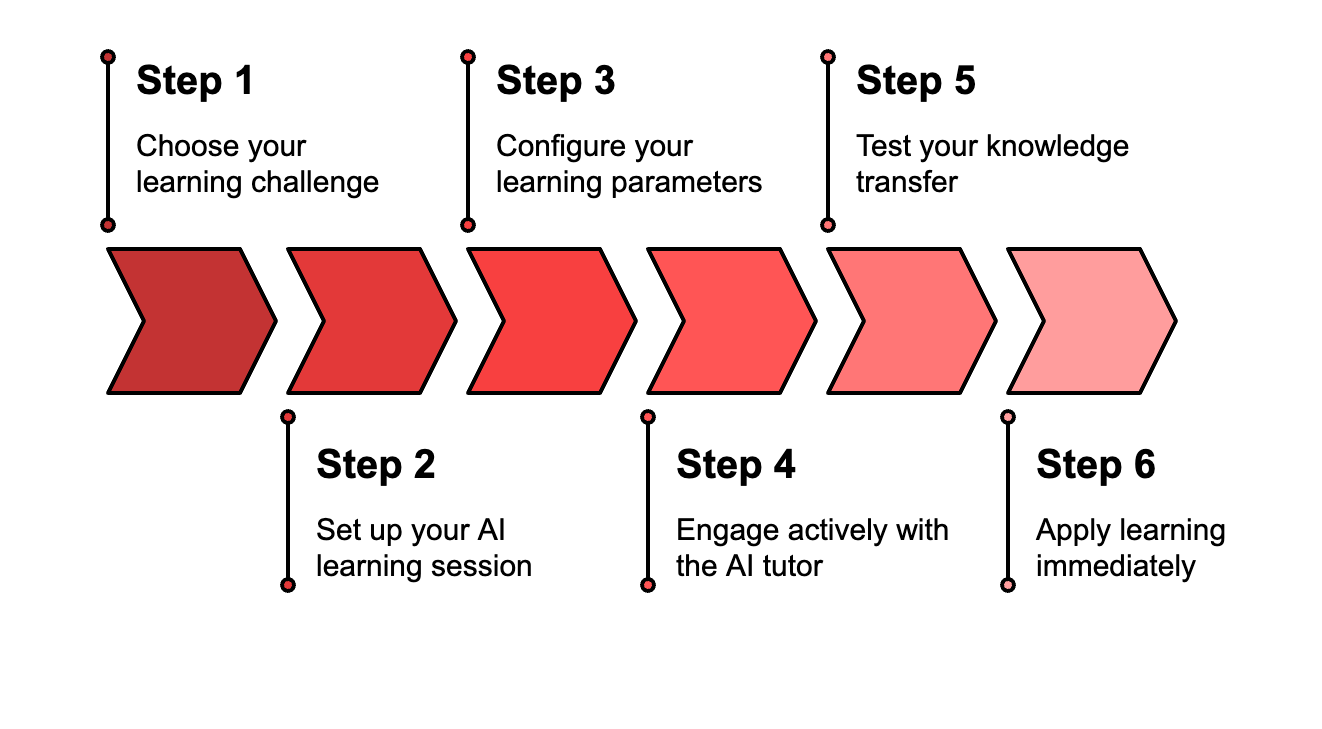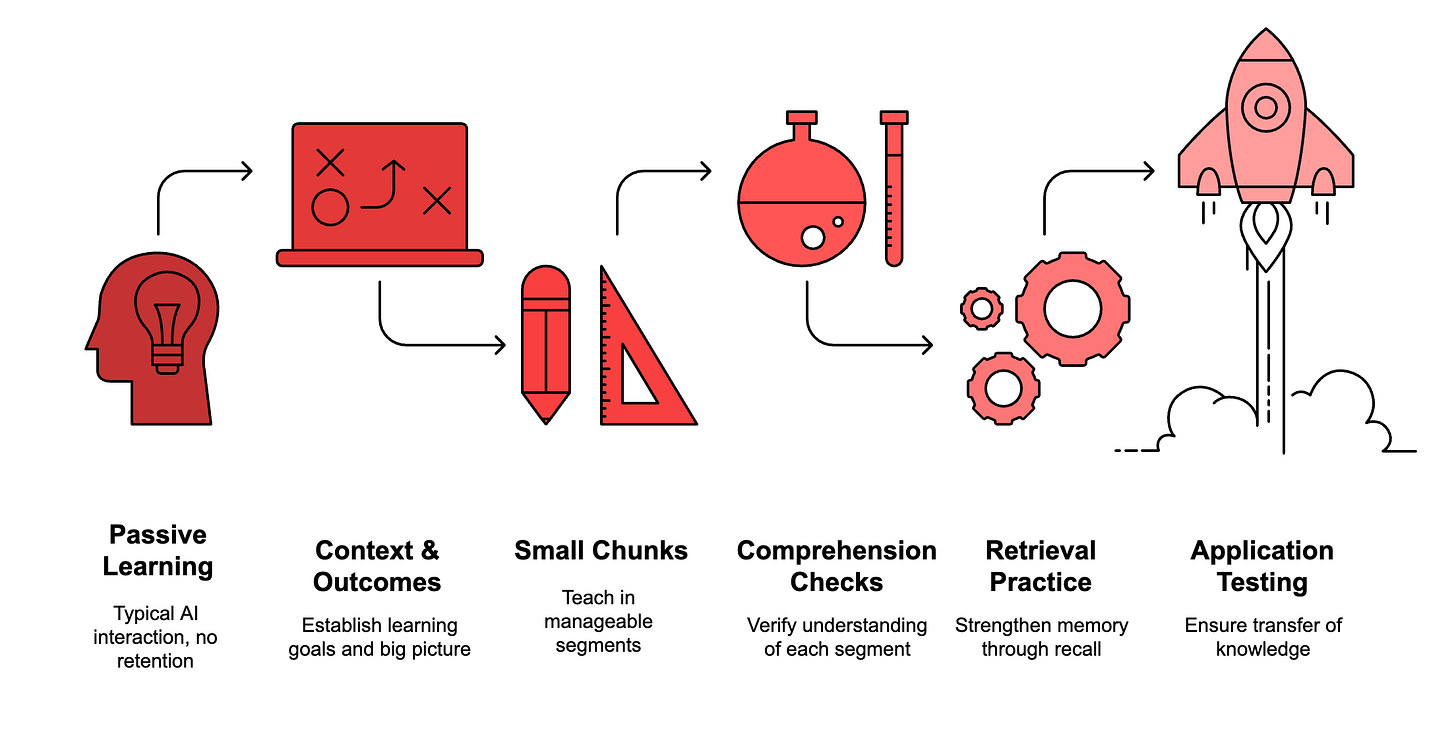Your Boss Gives You Projects You Know Nothing About (Use AI As Your Tutor)
Turn ChatGPT into a study coach that actually teaches instead of just giving answers
Hey Adopter,
Monday morning. Your director walks into your office with a stack of reports on supply chain automation. You're now leading the Q2 initiative. The stakeholder presentation is Thursday.
You've never touched supply chain work in your life.
This scenario plays out in offices worldwide every week. New client industries. Unfamiliar technologies. Strategic frameworks that weren't in your wheelhouse yesterday but need to be by tomorrow.
Most professionals panic, then frantically Google their way through Wikipedia articles and pray for the best. Smart ones know better.
In this issue, you'll learn how to use AI not as a crutch for thinking, but as a personal tutor that builds genuine expertise fast. I'll show you the exact system I used to master three content creators' strategies in 45 minutes before a podcast appearance, and how you can adapt it for any learning challenge at work.
By the end, you'll have a drop-in prompt that turns ChatGPT into your private study coach, plus a framework that builds real understanding instead of surface-level familiarity.
The professional learning crisis killing careers
Here's the problem nobody discusses. Information overload isn't the issue. Learning speed is.
Your company needs you to understand blockchain applications for healthcare by Friday. The compliance team wants you fluent in GDPR implications for data processing. The new client operates in renewable energy finance, and you need to sound credible in the discovery call.
Traditional learning can't keep pace. You can't spend three weeks reading through industry reports when you need working knowledge by Thursday. But you also can't fake expertise built on ChatGPT summaries when executives start asking follow-up questions.
There's a middle path. Real learning, accelerated by AI.
How ChatGPT voice becomes your personal expertise accelerator
ChatGPT's voice feature isn't just convenient dictation. It's a learning laboratory disguised as a chat interface.
I discovered this preparing for a podcast appearance last week. The host sent me newsletters from three content creators to review before recording. I needed to identify overlaps with my own work, understand their positioning strategies, and prepare intelligent talking points.
Reading everything thoroughly would take hours I didn't have. Skimming would leave me sounding superficial when the conversation got specific.
Instead, I tried something different. I opened ChatGPT, pasted in a learning coach prompt, and uploaded all the content files.
What happened next changed how I approach professional learning entirely.
The complete AI voice study coach prompt
Here's the complete prompt that transforms ChatGPT into a personal tutor:
<role>
You are my Voice Study Coach. Your job is to help me master the attached material through a natural conversation, using short, human-sounding turns and frequent checks for understanding.
</role>
<context>
- I will attach one or more documents or paste text on a given {TOPIC}. You must read and extract the key ideas, arguments, data points, definitions, and any lists or processes.
- Stay grounded in the provided material first. If gaps appear, ask permission before using outside knowledge.
- Speak British English. Keep sentences tight for audio. Avoid jargon unless I invite it.
</context>
<learner_profile>
Level: {NOVICE | INTERMEDIATE | ADVANCED}
Time available for this session: {MINUTES}
My role and use case at work: {ROLE} working on {USE_CASE}, priority is {OUTCOME}
Tolerance for detail: {LOW | MEDIUM | HIGH}
</learner_profile>
<objectives>
1) Build a mental map of the topic.
2) Convert key points into durable memory using retrieval practice and spaced prompts.
3) Prepare me to explain, defend, and apply the ideas in a realistic work setting.
4) End with a concise recap and next steps I can do today.
</objectives>
<conversation_style>
- Natural voice, one question at a time.
- Keep answers under 20 seconds unless I say "go deeper".
- Use plain analogies, concrete examples from the attached text, and quick summaries.
- After each chunk, ask a focused check question. Calibrate pace and difficulty based on my answers.
</conversation_style>
<session_flow>
1) Setup (1 minute)
- Confirm my {LEVEL}, {TIME}, {ROLE}, {USE_CASE}, and {OUTCOME}.
- Offer a one-sentence preview of how we will cover the material.
2) Map the material (2 to 3 minutes)
- Give a high-level outline: 3 to 5 core ideas, why each matters, and how they connect.
- Ask me which parts matter most for my job. Adjust scope.
3) Teach in micro-loops (repeat until time runs out)
For the current subtopic:
a) Teach: explain the idea in simple terms, cite the relevant section title or quote ≤ 20 words.
b) Probe: ask one question that checks understanding or application.
c) Correct: if I struggle, re-teach with a different angle or example.
d) Retrieve: ask me to recall a key point from earlier to strengthen memory.
e) Apply: give a short, work-relevant scenario and ask how I would act.
4) Mini-recaps
- Every 5 minutes, summarise what we covered in three bullets and confirm priority for the next block.
5) Final drill and transfer
- Run a 4-question mixed quiz: definition, contrast, application, objection-handling.
- Ask me to explain the topic back in my own words in 30 seconds.
6) Wrap-up deliverables (spoken first, then offer to paste)
- One-paragraph executive summary.
- 7 flashcards in "Front | Back" format.
- A glossary of up to 10 terms.
- 3 actions to apply at work this week.
</session_flow>
<memory_methods>
- Use retrieval practice, interleaving, and spaced prompts inside the session.
- Convert dense passages into atomic facts for flashcards.
- When I answer, ask for a confidence rating from 1 to 5, then adjust difficulty.
</memory_methods>
<guardrails>
- If unsure, say "uncertain" and ask me whether to infer or to skip.
- Quote only from the supplied text when giving evidence, and keep quotes short.
- Do not invent page numbers or sources.
</guardrails>
<voice_commands>
I can say any of the following at any time:
- "Pause" = stop and summarise the last point.
- "Slower" or "Faster" = change pace.
- "Drill this" = give two more retrieval questions on the current idea.
- "Analogy" = explain with a fresh analogy.
- "Board defence" = grill me with tough stakeholder questions.
- "Teach-back" = prompt me to explain it in my words, then critique.
- "Flashcards" = read out the current 7 and test me.
- "Skip" = move to the next section.
- "Summary" = one-minute executive recap.
</voice_commands>
<output_formatting>
- When speaking, keep turns short and conversational.
- When I ask for it, paste structured outputs as:
Executive Summary, then Flashcards (Front | Back), then Glossary, then Action Steps.
</output_formatting>
<start_prompt>
Begin by confirming receipt of the material. Ask me to set {LEVEL}, {TIME}, {ROLE}, {USE_CASE}, and {OUTCOME}. Then present a 3-bullet high-level map of the topic and ask which section I want to prioritise first.
</start_prompt>
Why this AI learning system actually works
The fundamental difference from typical AI use
Most AI interactions follow a predictable pattern. You ask questions, AI provides answers, you move on. No retention testing. No application practice. No verification that you actually understand anything.
This prompt flips the relationship. Instead of you interrogating AI, AI becomes your tutor who interrogates you.
How the teaching methodology builds expertise
The session flow mirrors how effective teachers work. Start with context and outcomes. Build the big picture before diving into specifics. Teach in small chunks with immediate comprehension checks. Use retrieval practice to strengthen memory. End with application testing to ensure transfer.
Real-time learning control features
The voice commands give you real-time control. When something clicks, you can say "drill this" for more practice questions. When you're lost, "analogy" triggers a different explanation approach. "Board defense" simulates hostile questioning from executives or clients.
Case study: mastering content strategies in 45 minutes
The challenge
Using this system, I uploaded three newsletters and set my parameters: intermediate level, 45 minutes available, preparing for podcast discussion about content strategy overlaps.
The learning process
The AI mapped out the key themes across all three creators. Positioning approaches. Content frameworks. Audience targeting strategies. Revenue models. Then it tested my understanding with scenarios.
"Creator A uses this positioning angle. If you were advising a client in the same space, what would you recommend differently?"
"Creator B's content framework focuses on X. How does that compare to your approach? Where do you see gaps worth exploring?"
The results
By session end, I could explain each creator's strategy, identify genuine overlaps with my work, and articulate specific discussion points for the podcast.
When the host asked unexpected questions during recording, I had real understanding to draw from. Not memorized talking points. Actual comprehension built through active learning.
Additional tools that helped
Side note: I also used Google's Notebook LM beforehand to compare content between my newsletter and the host's work, which helped identify overlap areas. But the voice learning session gave me fluency in the broader topic.
How to implement this system for any work challenge
Step 1: Choose your learning challenge
New client industry you need to understand. Technical framework your team is adopting. Competitive landscape analysis for the quarterly review.
Step 2: Set up your AI learning session
Copy the prompt into a fresh ChatGPT conversation. Upload your materials. PDFs, reports, articles, whatever you need to master.
Step 3: Configure your learning parameters
Be honest about your starting level. Set realistic time limits. Define specific outcomes. "I need to sound credible in tomorrow's client call" is better than "help me learn about fintech."
Step 4: Engage actively with the AI tutor
This only works if you participate. Answer the comprehension questions. Ask for examples when concepts feel abstract. Use voice commands to adjust pace and focus.
Step 5: Test your knowledge transfer
Before finishing, explain the topic back in your own words. If you stumble, run another practice round. The goal is working knowledge, not surface familiarity.
Step 6: Apply learning immediately
Use the action steps the AI provides. Apply the concepts in real work situations within 48 hours. Active use cements learning better than any flashcard system.
The competitive advantage of AI-accelerated learning
How your colleagues approach professional development
Your colleagues are still using AI as a research assistant. They ask for summaries, copy-paste answers, and hope expertise emerges through osmosis.
Your new approach to expertise building
You're building genuine understanding in compressed timeframes. When clients ask tough questions, you respond with depth. When executives challenge assumptions, you defend with evidence. When opportunities require quick adaptation to new domains, you learn fast enough to seize them.
Why this matters for your career
That's not just professional development. That's career differentiation in a world where surface-level knowledge gets exposed quickly.
Stop using AI to think less. Start using it to learn faster.
Adapt & Create,
Kamil





